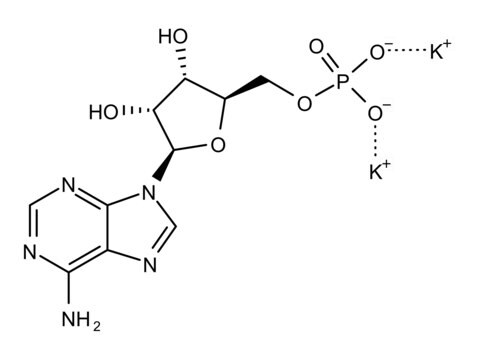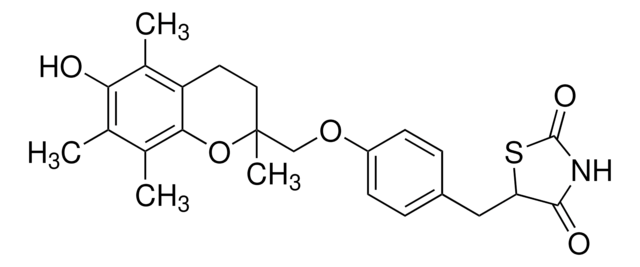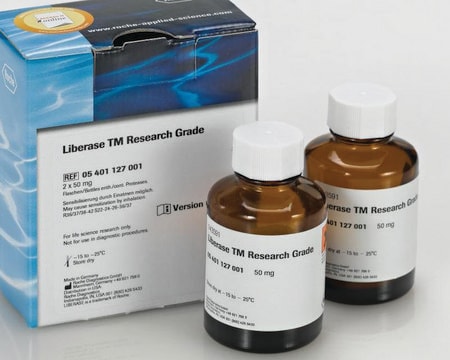SRP0195
PARP6 Active human
recombinant, expressed in baculovirus infected insect cells, ≥70% (SDS-PAGE)
Synonyme(s) :
MGC131971, Poly (ADP-ribose) Polymerase 6, pART17
Se connecterpour consulter vos tarifs contractuels et ceux de votre entreprise/organisme
About This Item
Code UNSPSC :
12352200
Nomenclature NACRES :
NA.32
Produits recommandés
Source biologique
human
Produit recombinant
expressed in baculovirus infected insect cells
Pureté
≥70% (SDS-PAGE)
Forme
aqueous solution
Poids mol.
98 kDa
Conditionnement
pkg of 10 μg
Concentration
>0.02 mg/mL
Numéro d'accès NCBI
Numéro d'accès UniProt
Conditions d'expédition
dry ice
Température de stockage
−70°C
Informations sur le gène
human ... PARP6(56965)
Description générale
PARP6 (poly(ADP-ribose) polymerase family member 6) gene is localized to human chromosome 15q23. It is a member of the family of multifunctional nuclear proteases known as PARPs, which contains 17 members and is further classified into three subtypes dependent on the catalytic domain structure. PARP6 is a type of mono(ADP-ribosyl) transferase on the basis that its catalytic domain has a significantly shorter nicotinamide-ribose-binding site than PARP1. This subfamily contains nine members including PARP6. PARP6 is composed of 630 residues and has a molecular weight of 71kDa.
Human PARP6 (GenBank Accession No. NM_020214), full length with N-terminal GST tag, MW = 98kDa, expressed in a Baculovirus infected Sf9 cell expression system.
Human PARP6 (GenBank Accession No. NM_020214), full length with N-terminal GST tag, MW = 98kDa, expressed in a Baculovirus infected Sf9 cell expression system.
Application
Useful for the study of enzyme kinetics, screening inhibitors, and selectivity profiling.
Actions biochimiques/physiologiques
PARP6 (poly(ADP-ribose) polymerase family member 6) negatively controls cell cycle, as its ectopic expression in HeLa cells leads to suppression of cell growth. It functions as a tumor suppressor in CRC (colorectal cancer), and its expression is associated with good prognosis. The ectopic expression of PARP6 results in suppressed expression of the oncogene survivin. In CRC PAPR6 prevents colony formation, invasion, migration, and cell proliferation.
Définition de l'unité
One unit of PARP incorporates 100 pmoles of poly(ADP) in 1 minute (room temperature) from NAD into acid-insoluble form.
Forme physique
Formulated in 25 mM Tris-HCl, pH 8.0, 100 mM NaCl, 0.05% Tween-20, 50% glycerol and 3 mM DTT.
Notes préparatoires
Thaw on ice. Upon first thaw, briefly spin tube containing enzyme to recover full content of the tube. Aliquot enzyme into single use aliquots. Store remaining undiluted enzyme in aliquots at -70°C. Note: Enzyme is very sensitive to freeze/thaw cycles.
Certificats d'analyse (COA)
Recherchez un Certificats d'analyse (COA) en saisissant le numéro de lot du produit. Les numéros de lot figurent sur l'étiquette du produit après les mots "Lot" ou "Batch".
Déjà en possession de ce produit ?
Retrouvez la documentation relative aux produits que vous avez récemment achetés dans la Bibliothèque de documents.
Guangying Qi et al.
Oncotarget, 7(14), 18812-18824 (2016-03-05)
Poly (ADP-ribose) polymerases (PARPs) are enzymes that transfer ADP-ribose groups to target proteins and are involved in a variety of biological processes. PARP6 is a novel member, and our previous findings suggest that PARP6 may act as a tumor suppressor
Handan Tuncel et al.
International journal of oncology, 41(6), 2079-2086 (2012-10-09)
Poly(ADP-ribose) polymerase (PARP) is an enzyme that mediates post-translational modification of proteins. Seventeen known members of the PARP superfamily can
Notre équipe de scientifiques dispose d'une expérience dans tous les secteurs de la recherche, notamment en sciences de la vie, science des matériaux, synthèse chimique, chromatographie, analyse et dans de nombreux autres domaines..
Contacter notre Service technique




